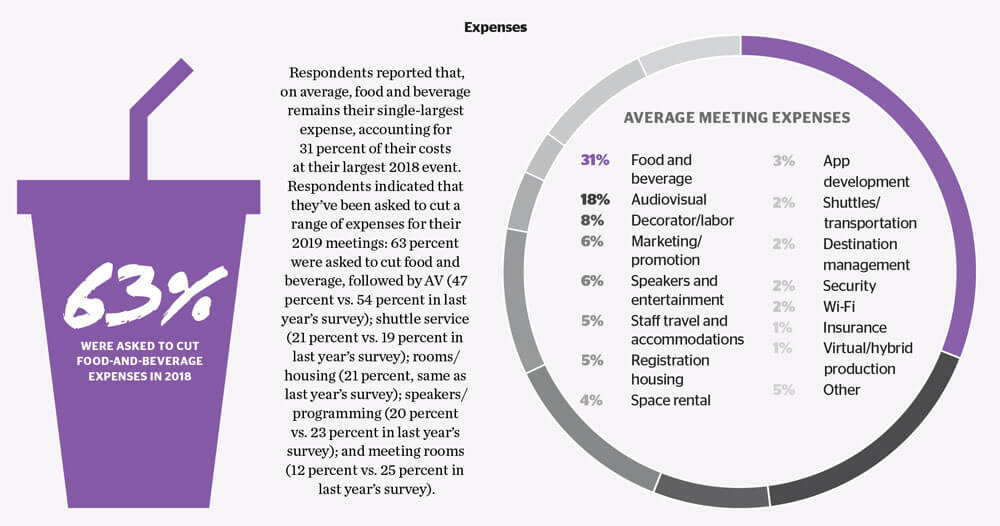
Chefs at the 2018 PCMA Annual Conference in Bangkok serve pasta and other dishes to attendees. In the 28th Annual Meetings Market Survey, respondents listed rising food and beverage costs as a major challenge.
As part of the 28th Annual Meetings Market Survey, we asked respondents a handful of open-ended questions, including: “What is the biggest challenge facing the meetings industry today?” Budgets and rising costs were frequently mentioned, with AV, food and beverage, and Wi-Fi expenses standing out as particular pain points.
Hotels were a recurring topic, as planners noted a decrease in the ability to negotiate contracts, along with pressures associated with lowered commissions and increased competition for space.
Although the overall survey results paint an optimistic picture for 2019, individual responses reveal pockets of anxiety. Many planners put safety and security at the top of the list of meetings industry’s challenges, while others noted “customers’ travel fears,” the “unstable world,” and “the impending economic downturn.”
Find a complete list of the responses after the graphic below. For more from the survey, visit Convene’s 28th Annual Meetings Market Survey.

Convene’s Meetings Market Survey was prepared for PCMA by Lewis Copulsky, principal, Lewis & Clark. All material © 2019 by PCMA. Survey analysis by Michelle Russell. Graphics created by Point Five.
- Aligning priorities across suppliers, hoteliers, and planners.
- Ample workforce … government regulations!
- Attracting the next generation to participate in meetings.
- Attracting young professionals and bringing those members and mentors within any given institution and industry together face-to-face.
- Attracting younger attendees.
- Being the most innovative and ahead of the curve, because it’s constantly changing.
- Bringing the cost of technology down so that small meetings can use it. We have to track attendance for CEUs at our meetings and we are still using the age-old sign in sheets, because technology like smart badges or scanners are too cost-prohibitive for our 450-attendee meeting.
- Budget cuts both internally and externally (clients). Rising cost of food/beverage.
- Budget decreases.
- Budgets, security.
- Budgets.
- Changing technology and people’s expectation to have things customized to them.
- Changing the dynamics of third-party expertise and value to the meetings industry.
- Cities outpricing themselves within the market — making it harder for a planner to source.
- Clients affording events.
- Climate change.
- Competition. (3 mentions)
- Consolidation.
- Easy, consolidation. When Marriott-owned organizations are the only game in town, your choices and the ability to negotiate goes down to zero.
- Contracts and dealing with our volunteers.
- Convincing employers to send their employees [to meetings].
- Cost and security.
- Cost and time — delegates seem to have less time to spend/travel to meetings and conferences.
- Cost control seems to be an issue.
- Cost of events and market saturation.
- Cost of hosting a meeting.
- Costs, particular rising cost of travel.
- Costs.
- Country issue.
- Declining association management.
- Developing young talent.
- Economy, travel restrictions, GDPR.
- Encouraging members to attend.
- Escalating rates — hotel, food and beverage, transportation.
- Finding funding.
- Finding large venues with availability.
- For me, it’s competition with larger associations that have bigger budgets and/or more to offer a destination and hotel(s).
- The number of hotels willing to return proposals has declined this past year.
- Getting bums in seats.
- Hard to find a venue that is unconventional, at a reasonable price, spacious, complemented with natural day light.
- High demand, low supply.
- Hotel greed.
- Hotel negotiations.
- Hotel room rates. USA hotels/cities/CVBs work so differently than global cities and associations. Time for a reality check in the USA because delegates refuse to pay high hotel room rates when there are so many alternative options available! This has actually hurt our attendance and our ability to get into many cities in the USA. Associations should not ever have to pay attrition when bringing a citywide convention to this country!
- Hoteliers lowering commission rates and planning hybrid events.
- Housing blocks.
- Housing piracy!
- Housing.
- I believe the No. 1 challenge is being able to reinvent itself without alienating an entire group of attendees/members, finding the balance between the emerging technologies and the comfort level some need.
- Increased pricing in FB, AV, and service charges are making doing meetings close to impossible for non-profit organizations.
- Increasing costs and options.
- Increasing costs pushing more virtual events vs. tradition on-site.
- Inexperience and perception of meeting professionals.
- Innovation.
- Internet and other technology.
- Keeping face-to-face meetings/events relevant.
- Keeping them fresh.
- Keeping up with technology and changes.
- Lack of budget means attendees have to be more selective to what they can attend.
- Lack of supply from hotels.
- Lack of time for people to attend meetings. Reduced budgets to both attend a meeting and plan a meeting. Changing demographics of attendees.
- Losing sight of the people connections in the midst of technological glitter. Also bridging the gap of staying useful to senior participants while engaging and becoming relevant to newer participants.
- Low budgets.
- Lower budgets for travel and in-person education events.
- Meaningful connections. Making time out of the office worth it.
- Membership/participation. RSVPs/head counts/waste/overbooking.
- Misconduct at meetings. And affordable hotel rates close to meeting facilities.
- Not enough recognition for the strategic and financial successes that meetings are central to for the organizations in which they work.
- Not sure it is No. 1, but I know that staying outside the room block is an issue for many planners.
- Out-wowing the internet, creating a networking opportunity that requires people meeting in person. Information is everywhere and easy to get.
- Perception of meetings/conventions as boondogles.
- Poaching hotels.
- Recognition.
- Relying on a commission as the basis for your strategy.
- Right now redefining how cities look at housing.
- Rising costs. (3 mentions)
- Risk management.
- Safety and the impending economic downturn.
- Safety concerns.
- Security and continuous improvement/creativity.
- Security issue.
- Seller’s market and security.
- Seller’s market with less and less ability to negotiate
- Separations of sales with folks that actually deliver.
- Social media.
- Status quo.
- Staying on top of the fast-paced evolution of change that is happening.
- Staying relevant and attracting younger audiences.
- Sustainability.
- The current U.S. administration.
- The economy as a whole.
- The next generation of planners who do not yet see this as a career but a job. Thus they set limits on the time for work … both a positive and a negative.
- The No. 1 challenge facing the meetings industry is probably delivering content that drives attendee interest and creating an experience for them while they attend the meeting.
- The overall lack of respect for the profession. Rising costs are an issue, especially as suppliers will be competing with the sharing economy.
- The shift from a buyer’s market to a seller’s market. I’m beginning to feel the effects of hotels claiming a stronger hold on their offerings. We’re forced to do more with less.
- There is so much emphasis on “experiental” events and not as much emphasis on actual education/content/learning.
- Tight budgets for travel.
- Tightening economy, companies willing to spend less and take less people to meetings.
- Too many meetings all competing for the same face time.
- Travel costs.
- Travel fears by customers.
- Trump.
- Unstable world — security issues, visa issues (Trump-factor).
- Value and cost. We are having trouble attracting an audience that is of great value to sponsors, but the cost of producing our events exceed the value of our events to attendees and potential attendees. We can never make enough on registration fees to make money on a meeting, but we’re having trouble attracting the sponsors to make it all work.
- Venue space.
- Virtual vs. in-person meetings — will attendees stay away if they don’t want to come to the meeting in person?
- Will virtual meetings create a downturn in attendance?
- Wi-Fi costs
- Wi-fi!
- With the Marriott/Starwood merger, less competition between a majority of hotels resulting in higher guest room rates.
